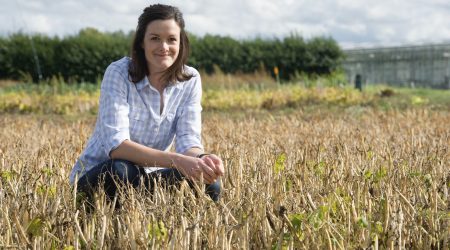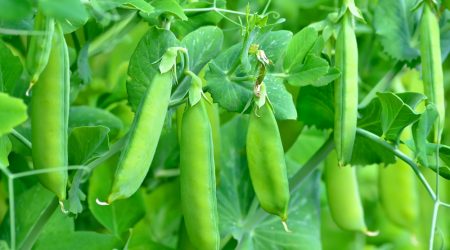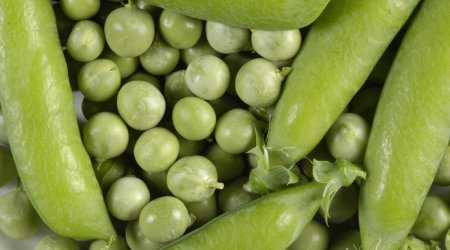The history of peas and genetics at the John Innes Centre dates back to 1850
1850-60s: Gregor Mendel established the basic understanding of the mechanism for inheritance
Long before the Institute was formed Mendel, a Moravian monk, selected the pea for this investigation because the plants and seeds have a wide array of distinct features, or traits, and a short growth period.
Over eight years and involving 28,000 pea plants, Mendel produced astonishing results, finding inheritance patterns for the seven traits he studied. He identified a consistent mathematical formula that explained the frequency with which each appeared and observed dominant and recessive traits.
William Bateson, the first director of the John Innes Horticultural Institution, introduced Mendel’s theory to Great Britain, coining the term “genetics” to describe the new science.
1910: The John Innes Horticultural Institution opened
Bateson started using peas in his research programme to further Mendelian genetics.
Around this time, a team of scientists in America were developing the revolutionary chromosome theory. Their theory recognised that “factors” (Mendel’s word for what became known as genes) are arranged on linear chromosomes and that each gene has its own particular location (locus) on a specific chromosome. Bateson remained sceptical.
Reginald Punnett, a colleague of Bateson’s, eventually retracted any doubt he had in the chromosome theory. He published a complete genetic analysis of the sweet pea in the Journal of Genetics and the results were consistent with the chromosomal theory of linkage – the tendency of DNA sequences that are close together on a chromosome to be inherited together during sexual reproduction.
Towards the end of his life, Bateson came to accept chromosome theory partially, but remained sceptical, arguing its inability to explain inheritance completely.
1915: The mystery of the rabbit-eared rogues
Initially, pea research at the John Innes Horticultural Institution focused on demonstrating and extending the principles of Mendelian inheritance. However, an exception emerged: the rogue pea posed an entirely new and unique enigma.
Bateson and Caroline Pellew focused on the “rabbit-eared rogues”, which exhibit reduced, dark green pointed leaflets and stipules that resemble rabbit ears. They observed that, when crossing rogues with normal peas, the offspring were always rogue – which defied the emerging rules of Mendelian inheritance.
It was in fact the first detailed description of a phenomenon later known as paramutation.
Paramutation lies within the realm of epigenetics, which explains how observable traits may result from external factors such as environmental or diet-related stimuli which turn genes on or off and affect how cells express a gene.
Plant biology has made significant contributions to the discovery and study of epigenetics, which could be involved in some human diseases that can exhibit non-Mendelian inheritance such as diabetes and cancer.
1941: War and peas
World War Two had a dramatic effect on pea research at the John Innes Horticultural Institution due to changing priorities, depleted staff, and a lack of available funds. Consequently, pea research was put on hold.
It was not until the 1960s when the pea programme was reintroduced. At this time, a lot of plant-breeding programmes were being transferred away from the John Innes Institute. Therefore, Kenneth Dodds, the acting head of the Department of Applied Genetics, needed to find a plant unique to his department to settle its future.
Taking into account the previous work carried out by the early pea research pioneers Pellew, Bateson and Dorothea de Winton, Dodds selected the pea and kick-started the next generation of pea research at the John Innes Centre.
1980s: Finding the gene
John Innes researchers began investigating the biochemical differences between round and wrinkled seeds, two of Mendel’s famous traits.
The most significant breakthrough came in 1988, when Professor Alison Smith (pictured above) investigated a report that claimed that wrinkled peas were deficient in an enzyme called ‘starch-branching enzyme’ (SBE1).
Professor Smith found that the amount of starch in pea seeds depends on the presence or absence of SBE1. She observed how wrinkled seeds lack SBE1, which results in reduced starch production and hence higher sugar content and wrinkled seeds.
The final piece in the puzzle occurred when a group of our researchers, led by molecular geneticist Professor Cathie Martin, published their innovative investigation into the molecular biology of wrinkled peas.
The group had found that the SBE1 gene is located at the rugosus locus and wrinkled seeds have an extra piece of genetic material inserted into the SBE1 gene. The insertion prevents the normal expression of the gene and thus stops SBE1 being produced.
Mendel requested that all his scientific materials be destroyed upon his death. However, Professor Martin and colleagues are confident that SBE1 was the gene and the mutation studied by Mendel because this was the only mutant allele known at that time to confer wrinkled pea seeds, although other mutations are now known.
With this discovery, these John Innes Centre scientists became the first to describe the cloning and characterisation of one of Mendel’s genes.
2010: Unlocking Mendel’s white and purple pea flowers
In a worldwide collaboration, John Innes scientists solved the mystery of another of Mendel’s genes. They became the first to characterise the gene involved in the pigmentation of pea flowers and seed coats.
The pigments involved (anthocyanins) have attracted increased interest in recent years due to their antioxidant properties.
This is the fourth of Mendel’s seven pea genes to be cloned and characterised and the second at the John Innes Centre.
Genetics at the John Innes Centre
From its earliest days, through to modern bioscience, genetics has been a thread that has kept the John Innes Centre at the forefront of scientific endeavour.
Now, with the rapid expansion of genotyping, and the sequencing of both plants and microbes, we continue to work to understand more about the genetic codes which govern life.
The John Innes Centre aims to push the frontiers of knowledge, answering curiosity-led fundamental questions, and then to apply this understanding for the benefit of society.







